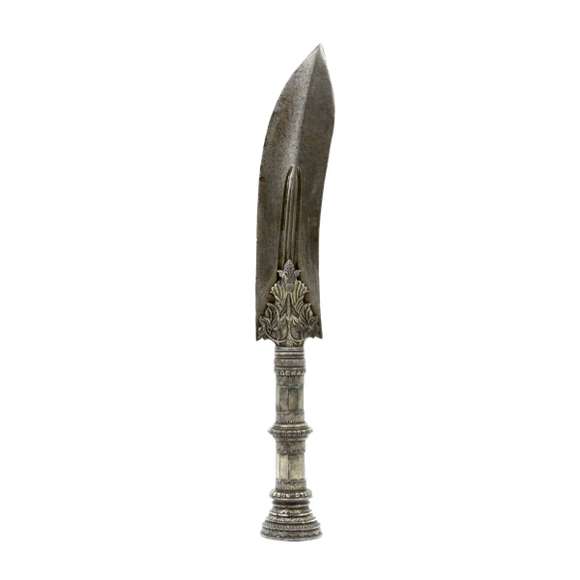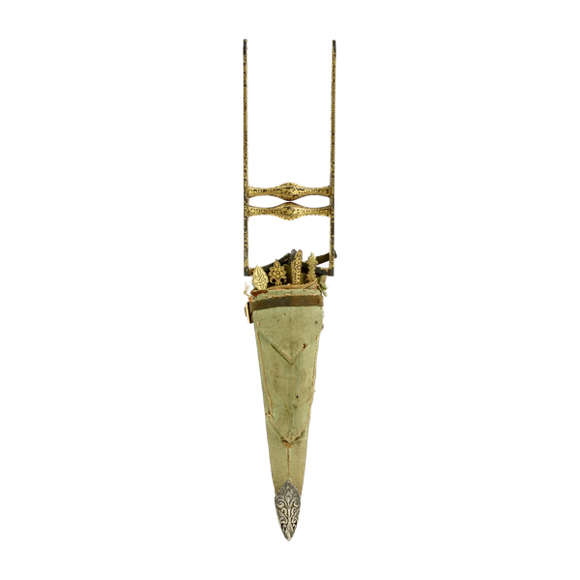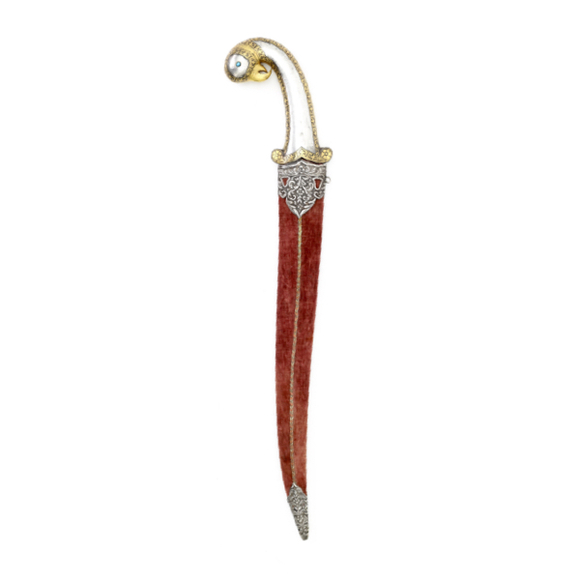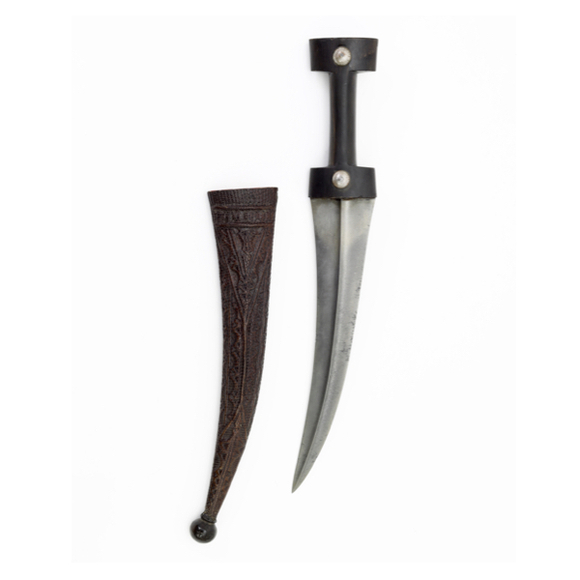After the Dutch set sail for Asia, they brought back many curiosities, including arms, some of which were used as props or subjects for paintings. The high level of realism of these paintings helps us in the study of early Asian arms, showing us what kind of styles were already around by that time.
1617, Frans Francken the Younger
"The Cabinet of a Collector"
Showing one of the earliest depictions of an Indonesian keris with a figural hilt. The style is typical for Banten, a Sultanate covering West Java and Southern Sumatra, situated around the port city of the same name. This is where the Dutch first set foot in Indonesia in 1595.1

"The Cabinet of a Collector"
Royal Collection Trust accession number RCIN 405781
Notes
1. Thanks to Michael Marlow for pointing this out. Also see: Kasten Sejr Jensen; Rembrandts Kris. Våbenhistorisk Tidsskrift Vol 31 nr 8. Copenhagen 1998. Pages 284-287. For the first-hand travel account, see: Isaac Commelin (compiler); Begin ende voortgangh van de Vereenighde Nederlantsche geoctroyeerde Oost-Indische compagnie. Amsterdam, Joannes Janssonius, 1646.
1625, Frans Francken the Younger
"Ulysses Recognizing Achilles among the Daughters of Lycomedes"
Showing the same keris lying in the foreground.

"Ulysses Recognizing Achilles among the Daughters of Lycomedes"
Department of Paintings of the Louvre, accession number RF 1535.
1628, Rembrandt van Rijn
"Samson and Delilah"
A little-known fact about Rembrandt is that he was an arms collector, who owned at least several swords, daggers, composite bows, and bow cases and quivers. He used some as props for some of his paintings.
This painting shows another keris in the foreground, again of a style pointing towards Banten, West Java.

"Samson and Delilah"
Private Collection

A keris with comparable hilt and scabbard, collected by the Japanese envoy Hasekura Tsunenaga.
Acquired in the Philippines circa 1619. Presently in the Sendai Museum, Japan.
1636, Rembrandt van Rijn
"The blinding of Samson"
This painting is interesting for its depiction of several Asian arms. The act of blinding is performed with a keris, probably the same as in "Samson and Delilah" because the story goes that his own weapon was used against him. It is held mid-blade so the elaborate hilt can be clearly seen.
The man on the left carries what appears to be a south Indian spear. At his belt is an atypical sword I have not been able to identify.
To the upper right we can see a man with a feather in his hat who is about to strike with what looks like an Ashanti akrafena sword.

"The blinding of Samson"
Städelmuseum, accession number 1383.

A 17th century south Indian "sang" spearhead.
Listed at Mandarin Mansion.

Detail of the keris.
1630 (circa), Jan Brueghel the Younger & Hendrick van Balen the Elder
"Allegory of Touch"
Part of a series covering all human senses. To the left we see a Japanese samurai armor, and on the floor a Mameluke style saber. On the right, on the floor, are two composite bows and some Ottoman bow cases and quivers.

"An allegory of touch"
Calvet Museum accession number 827.5.24.
1635 - 1640 (circa), Ferdinand Bol
"Portrait of a Young Man with a Sword"
Ferdinand Bol was a student of Rembrandt van Rijn, and this painting is considered one of his masterpieces.
A striking image of a young Dutch man with a very ornate Southeast Asian dha sword. It is one of the earliest clear depictions known of such a sword, predating most surviving antiques by about two centuries.
In the upper right-hand corner of the painting hangs an Ottoman bow case and quiver.

"Portrait of a young man with a sword"
Dayton Art Institute, accession number 1962.18.
1639 - 1640 (circa), Govaert Flinck
"A young archer"
A Moorish boy carrying an Asian composite bow and a back quiver. The Moors were predominantly Maghrebine Berbers but the term got loosely applied to many North African peoples.

"A young archer"
The Wallace Collection, accession number: P238.
1644, Harmen Steenwijck
"An Allegory of the Vanities of Human Life"
A still-life showing in the background a remarkable sword. At first glance, it seems Japanese, but many of the finer details are off. Rather, it points towards arms made in Southeast Asia. They were inspired by the swords brought by Japanese refugees who settled there in the late 16th to early 17th century and formed communities of traders and mercenaries who among others lend services to European operations in Asia.
(A lavish European interpretation of such a sword, following very similar proportions, was made by Thomas Kapustran, working in Klausenburg, Transylvania in 1674. Now in the Staatliche Kunstsammlungen Dresden, accession number Y 108.)

"An Allegory of the Vanities of Human Life"
The National Gallery, London, accession number NG1256.
1640s (circa), Harmen Steenwijck
An untitled vanitas painting
Another still-life shows a Southeast Asian copy of a Japanese sword. The style of pommel and chrysanthemum guard bear a resemblance to two swords from the Cornelis Tromp collection which were sent to Amsterdam in 1679 and are now in the Rijksmuseum in Amsterdam, accession numbers NG-NM-6097-B and NG-NM-6097-C.
There is also a Balinese keris hilt standing upright diagonally left of the lamp. This painting is the earliest depiction of this style of hilt known to me. The type remained in production until recent times.

Untitled Vanitas Painting
Courtesy of Rafael Valls Limited, London.
www.rafaelvalls.co.uk
1650s (circa), Harmen Steenwijck
"Vanitas still-life"
Another vanitas painting showing another southeast Asian sword in the Japanese style. It is much like the one portrayed in An Allegory of the Vanities of Human Life, but with minor differences in the hilt fittings.

Vanitas still-life
Lakenhal collection accession number S-408.
1644, Rembrandt van Rijn
"Man with a sword"
Depicting a figure that seems to be about to draw an Islamic sword with a typical crossguard as used in Persia and the Ottoman Empire.

Man with a Sword. The Leiden Collection accession number: RR-114
1644, Rembrandt van Rijn
"The Polish Rider"
A rider fully equipped with an Ottoman bow, bow case, quiver, war hammer, and two sabers. The saber in the background is a Polish saber, the one in the foreground appears to be Ottoman.

"The Polish Rider"
The Frick Collection, New York, accession number 1910.1.98.
I hope you enjoyed this short article. Do you know of other early European works of art with depictions of Asian arms? Let me know!
Mail: peter@mandarinmansion.com.







